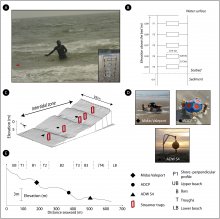I will present the abilities of numerical models to predict the morphodynamics over sandy beds. The flow field and the water depth are calculated using the depth-averaged hydrodynamic model. The work consisted in setting up the methodology of calculation. The principle is to make an external coupling of three codes: a swell propagation model; a one to simulate the currents and one to determine the morphodynamic evolution. The basic principle of this external coupling is to make this loop on the codes with a step of morphodynamic time depending essentially on weather conditions and on the hydrodynamic forcing of the studied site. These models are used in the framework of a simulated meteorological cycle describing the seasonal evolution of hydrodynamic factors.
The objectives through this study are multiple. First, we set up a procedure of linking of three codes to be able to simulate realistic climates. This technique of simulation will then use to compare and studied the contribution of the various formulae of sedimentary transport.
To calibrate all theses sediment formulae, we also compare our simulations with in-situ data of sediment transport measured (see fig. 1) on several beaches of the North Sea and of The English Channel (see fig. 2).







